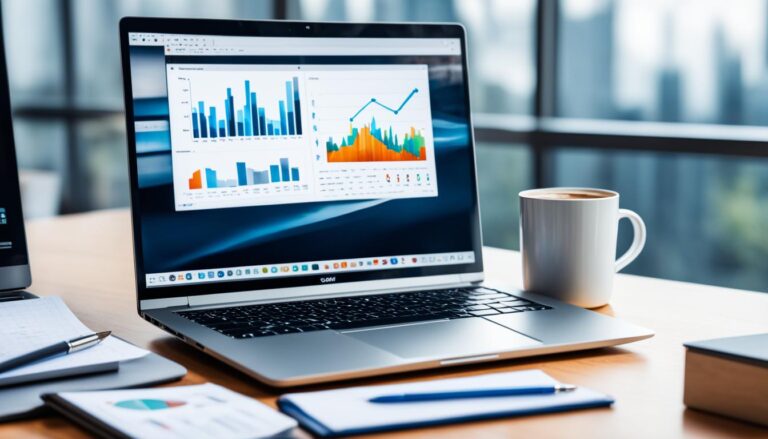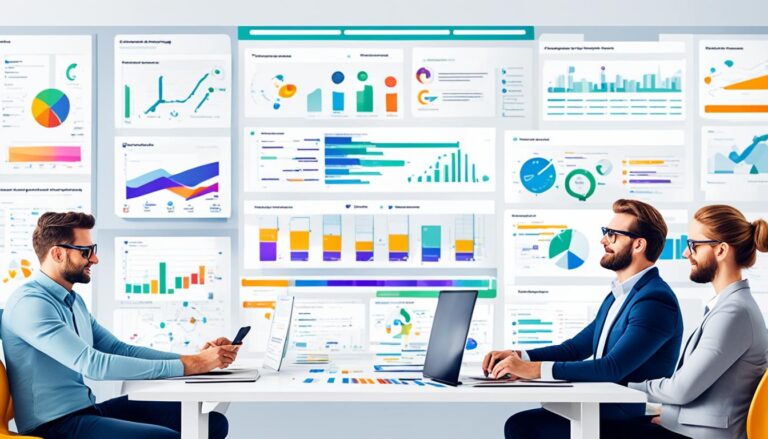Overcome Productivity Loss – Boost Your Efficiency!
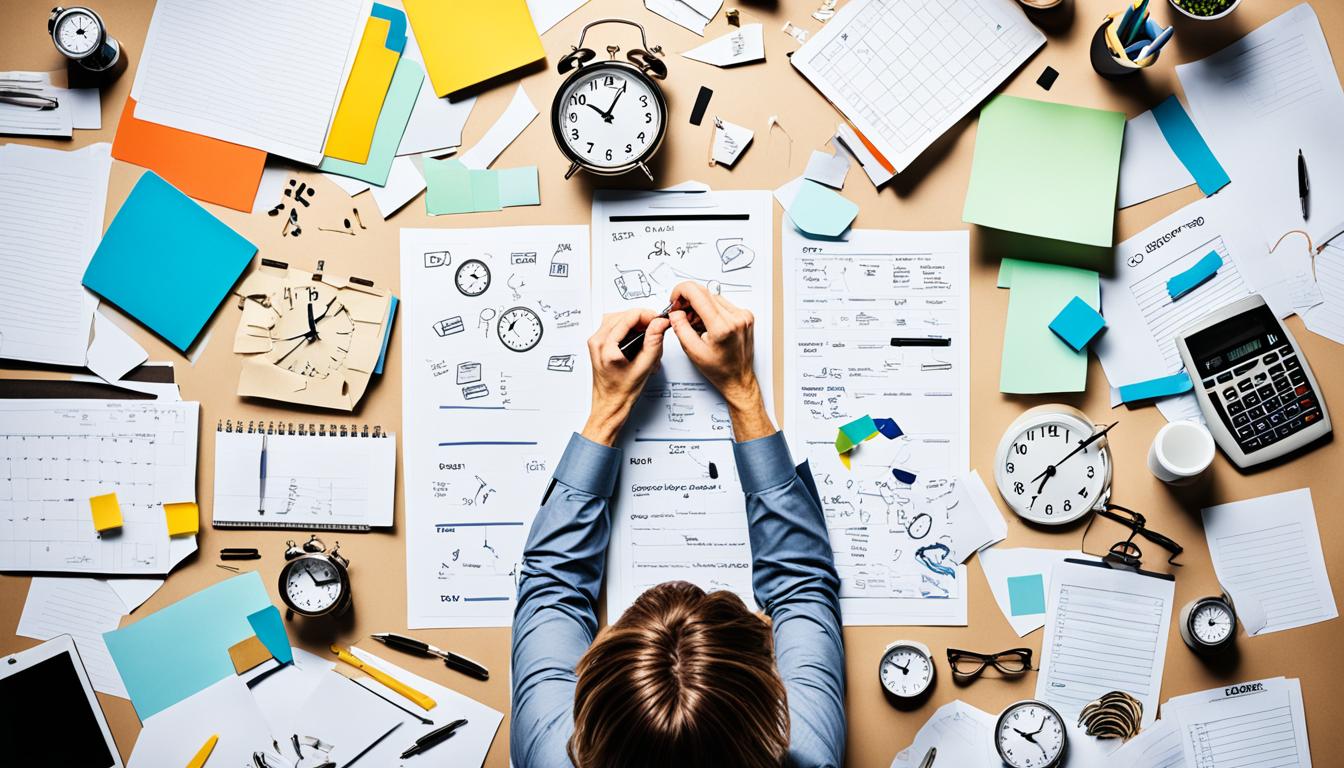
Are you tired of struggling to stay focused and meet deadlines? Do you wish you could accomplish more in less time? Productivity loss can have a significant impact on your work and overall success. But here’s the question: what if there were proven strategies and tools to help you overcome productivity loss and boost your efficiency at work?
It’s time to take control of your productivity and maximize your potential. In this article, we will explore the ways to improve productivity, the impact of productivity loss, productivity management strategies, reducing productivity loss, increasing efficiency at work, productivity tracking tools, causes of productivity decline, addressing productivity issues, and boosting team productivity. Discover effective tactics, techniques, and insights that will revolutionize the way you work.
Key Takeaways:
- Understand the impact of productivity loss and its effects on your work
- Implement proven tactics and techniques to improve your work efficiency
- Discover the key factors that contribute to an efficient team
- Find your own personalized approach to work efficiency
- Learn the difference between productivity and efficiency and how to optimize both
Proven Tactics for Higher Work Efficiency
Are interruptions and distractions affecting your work efficiency? According to a recent study by Atlassian, the average employee faces around 56 interruptions per day, resulting in a significant loss of productivity. But worry not, as there are proven tactics to help you overcome these challenges and boost your work efficiency.
Minimize Interruptions and Distractions
One of the key strategies for improving work efficiency is to minimize interruptions and distractions. By setting clear objectives and eliminating unnecessary disruptions, you can maintain focus and increase productivity. Here are some tactics to consider:
- Set Clear Objectives: Define specific goals for each task and break them down into measurable and achievable steps. This will provide clarity and help you stay focused.
- Allocate Responsibilities: Delegate tasks effectively within your team or organization. Clearly assigning responsibilities ensures that everyone knows their role and can work efficiently towards a common goal.
- Limit Multitasking: While multitasking may seem like a time-saving technique, it often leads to diminished productivity. Instead, prioritize tasks and work on them one at a time to maintain focus and complete them more efficiently.
- Prioritize Tasks: Prioritization is key to managing your workload effectively. Identify high-priority tasks and tackle them first, ensuring that your energy and attention are directed towards the most important objectives.
Track Your Time and Analyze Work Patterns
Tracking your time and analyzing work patterns can provide valuable insights for optimizing productivity. By understanding how you allocate your time and identifying patterns, you can make informed decisions to enhance work efficiency. Consider these tactics:
- Time Tracking: Use time tracking tools or apps to monitor how you spend your time on different tasks. This will help you identify areas where you may be spending excessive time or experiencing frequent interruptions.
- Goal Setting: Set realistic goals and create a schedule that allows you to allocate time accordingly. This will enable you to focus on important tasks and avoid wasting time on less productive activities.
- Resource Allocation: Determine your available resources, including time, tools, and personnel, and strategize their allocation accordingly. This will ensure that you have the necessary support to efficiently complete tasks.
By implementing these proven tactics, you can significantly improve your work efficiency, minimize interruptions, and increase productivity. Remember, a focused and organized approach is key to achieving optimal results. Stay tuned for the next section, where we explore what makes an efficient team.
What Makes an Efficient Team
An efficient team is essential for achieving high levels of productivity. To create an efficient team, it is crucial to focus on key factors such as clear processes, goal alignment, effective communication, and self-management.
Clear Processes: Establishing clear processes ensures that everyone understands their roles and responsibilities within the team. This clarity allows team members to work together more seamlessly and efficiently, minimizing any confusion or duplication of efforts.
Goal Alignment: It is important for team members to be aligned with the overall goals and objectives of the organization. When goals are clearly communicated and understood, everyone can work towards the same outcomes, maximizing productivity and minimizing wasted efforts.
Effective Communication: Communication is the key to any successful team. Effective communication fosters collaboration, problem-solving, and the sharing of information and ideas. By maintaining open and transparent channels of communication, team members can work together more efficiently and avoid misunderstandings or misalignment.
Self-Management: A culture of self-management promotes individual productivity within the team. When team members are self-motivated and take ownership of their tasks, they can effectively manage their time, prioritize their work, and drive their own productivity. This level of accountability empowers individuals and contributes to the overall efficiency of the team.
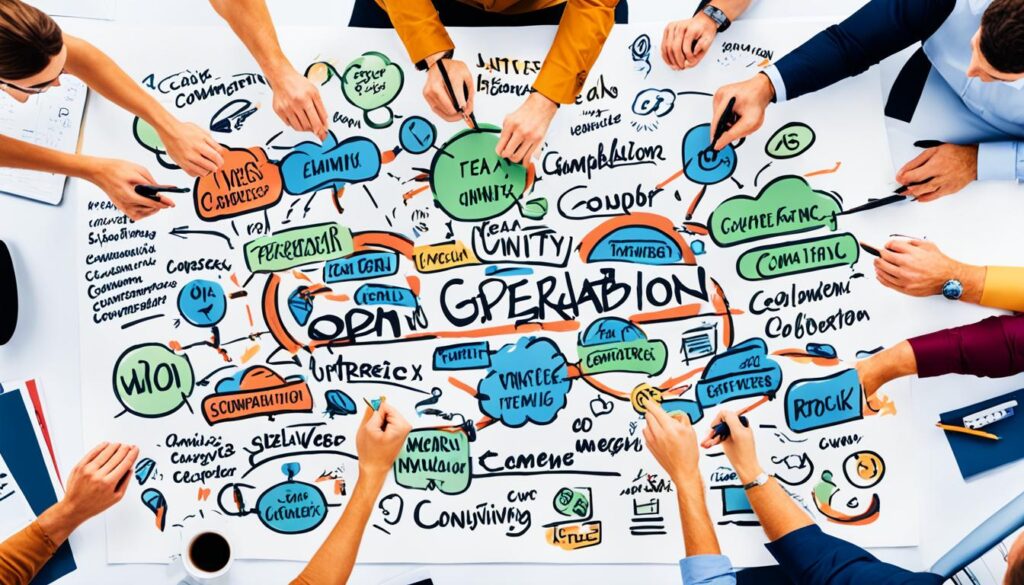
By focusing on these factors – clear processes, goal alignment, effective communication, and self-management – teams can become more efficient and productive. When everyone is on the same page, working towards the same objectives, and communicating effectively, the team can achieve higher levels of performance.
| Factors | Description |
|---|---|
| Clear Processes | Establishing and communicating clear processes within the team to minimize confusion and enhance efficiency. |
| Goal Alignment | Ensuring that all team members are aligned with the overall goals and objectives, focusing efforts towards common outcomes. |
| Effective Communication | Maintaining open and transparent channels of communication to foster collaboration and problem-solving. |
| Self-Management | Promoting a culture of self-accountability and productivity, where individuals take ownership of their tasks and manage their time effectively. |
Work Efficiency: Find Your Own Recipe
When it comes to work efficiency, there is no one-size-fits-all solution. Each individual works at their own pace and possesses unique strengths and weaknesses. To maximize your productivity, it’s vital to find a personalized approach that works best for you.
To optimize work efficiency, consider the following strategies:
- Task Prioritization: Determine the importance and urgency of tasks to effectively allocate your time and resources. This will help you focus on high-priority assignments and prevent time wastage.
- Focus: Minimize distractions and create a conducive work environment. Eliminate unnecessary interruptions, such as turning off mobile notifications or finding a quiet space to concentrate on your tasks.
- Motivation: Discover what drives you and use it as a source of inspiration. Set goals that align with your aspirations and continually remind yourself of the rewards and benefits that come with achieving them.
- Self-awareness: Reflect on your work habits, preferences, and patterns. By understanding your strengths and areas for improvement, you can adapt your approach accordingly and optimize your productivity.
Remember, work efficiency is a journey of self-discovery. Experiment with different techniques, observe what works best for you, and refine your approach over time. By customizing your work methods to suit your individual needs, you can unlock your full potential and achieve greater productivity.
Benefits of Work Efficiency:
A personalized approach to work efficiency offers several advantages:
- Improved time management
- Reduced stress and overwhelm
- Enhanced focus and concentration
- Increase in task completion
- Boosted job satisfaction
By prioritizing tasks, maintaining focus, staying motivated, and being self-aware, you can harness the power of work efficiency and unlock your true potential.
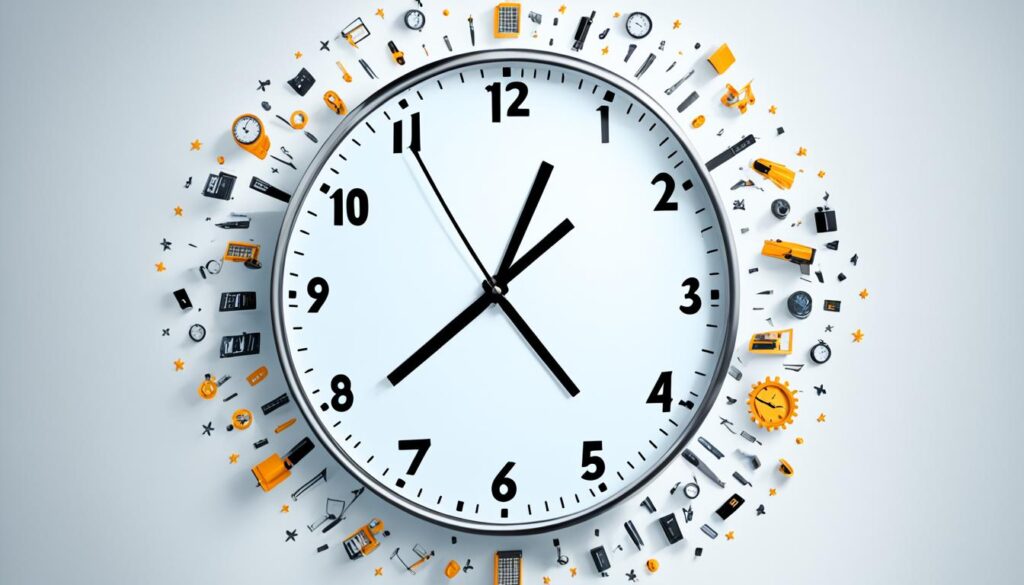
| Task Prioritization | Focus | Motivation | Self-awareness |
|---|---|---|---|
| Allows you to allocate time and resources effectively | Minimizes distractions and maximizes concentration | Acts as a driving force for productivity | Helps you identify strengths and areas for improvement |
| Enables completion of high-priority assignments | Creates a conducive work environment | Boosts job satisfaction and fulfillment | Adapts work methods to optimize productivity |
The Definition of Productivity and Efficiency
Productivity and efficiency are two important concepts in the realm of work and task completion. While they are often used interchangeably, they have distinct meanings and implications. Understanding the difference between productivity and efficiency can help individuals and teams optimize their performance and achieve better results.
Productivity can be defined as the measure of how much work can be accomplished within a given timeframe. It focuses on the output and the amount of tasks completed. A highly productive individual or team can accomplish more work in the same amount of time compared to those with lower productivity.
Efficiency, on the other hand, refers to the optimal utilization of resources to complete tasks. It is about achieving the desired output with minimal wastage. Efficient individuals or teams can accomplish the same amount of work while utilizing fewer resources such as time, effort, or materials.
An effective way to understand the difference between productivity and efficiency is through an analogy:
Think of productivity as a car that can travel a certain distance in a given time. If you increase the car’s speed, it can cover more ground within the same time frame, thus increasing productivity. Efficiency, on the other hand, is about optimizing the car’s fuel consumption. With efficient driving techniques, you can cover the same distance while using less fuel, achieving higher efficiency.
Applying this analogy to work, improving productivity involves finding ways to complete more tasks within a specific timeframe. It can be achieved through strategies such as effective time management, prioritization, and multitasking. On the other hand, enhancing efficiency involves streamlining processes, eliminating unnecessary steps, and utilizing resources wisely to achieve the same level of task completion.
Maximizing productivity and efficiency requires a balanced approach. Focusing solely on productivity without considering efficiency may lead to resource wastage and burnout. Conversely, focusing too much on efficiency without prioritizing productivity can result in decreased task completion and missed deadlines.
In summary, productivity is about accomplishing more work in the same amount of time, while efficiency is about achieving the same level of work with fewer resources. By understanding and optimizing both productivity and efficiency, individuals and teams can achieve higher levels of performance and maximize their potential.

| Aspect | Productivity | Efficiency |
|---|---|---|
| Definition | Measure of how much work can be done in a given time frame | Optimal utilization of resources to complete tasks |
| Focus | Output and amount of tasks completed | Achieving desired output with minimal wastage |
| Goal | Accomplishing more work in the same amount of time | Achieving the same level of work with fewer resources |
| Strategies | Effective time management, prioritization, and multitasking | Streamlining processes, eliminating unnecessary steps, and resource optimization |
Reasons People Struggle to Be Productive
Productivity is the key to achieving your goals and maximizing your potential. However, there are several common reasons why people often find themselves struggling to be productive. Let’s explore these challenges and understand how to overcome them.
1. Distractions
Distractions can quickly derail your focus and hinder your productivity. In today’s digital age, technology and social media are major culprits. The constant notifications, like a siren’s call, can easily divert your attention away from important tasks. To combat distractions:
- Implement time management techniques to allocate dedicated slots for online activities.
- Minimize external interruptions by silencing notifications or using productivity apps.
- Designate specific periods for focused work, free from distractions.
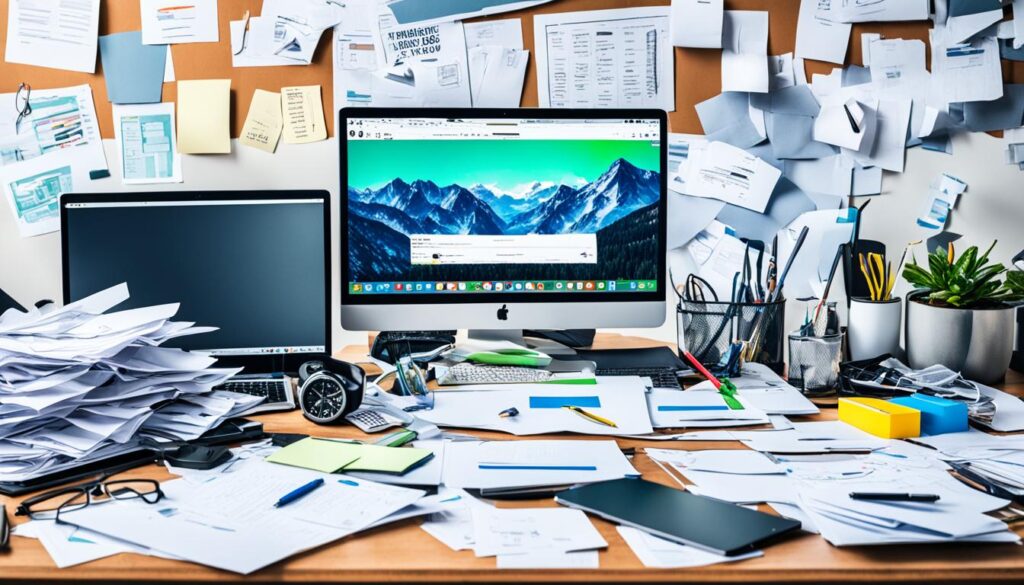
2. Lack of Direction
Without a clear sense of direction, it becomes challenging to prioritize tasks effectively. A lack of direction leads to confusion about which tasks deserve your attention and effort. To overcome this obstacle:
- Set clear objectives and break them down into smaller, manageable tasks.
- Establish a prioritization system based on importance and urgency.
- Regularly review your goals and align your tasks accordingly.
3. Boredom with Tasks
Boredom or difficulty with tasks can significantly impact your motivation and productivity levels. When tasks seem tedious or uninteresting, it’s easy to procrastinate and delay their completion. To combat boredom and stay productive:
- Find ways to make mundane tasks more engaging, such as adding variety or incorporating gamification elements.
- Break down larger tasks into smaller, more manageable parts to reduce overwhelming feelings.
- Reward yourself upon completing challenging or boring tasks to stay motivated.
4. Starting Late in the Day
The time you choose to start your day plays a significant role in your productivity. Starting late in the day limits the amount of time available for focused work, as fatigue and distractions tend to increase as the day progresses. To optimize your productivity:
- Adopt an early riser routine to take advantage of quiet and uninterrupted mornings.
- Create a morning ritual that includes activities to energize your mind and body.
- Prioritize your most important and challenging tasks during your peak energy periods.
| Root Cause | Impact on Productivity | Solution |
|---|---|---|
| Distractions | Diverts attention and decreases focus | Minimize technology-related interruptions, allocate dedicated work hours, and create a focused work environment. |
| Lack of Direction | Unclear prioritization and difficulty focusing | Set clear objectives, break down goals into smaller tasks, and establish a prioritization system. |
| Boredom with Tasks | Decreases motivation and procrastination | Make tasks more engaging, break them down, and reward yourself upon completion. |
| Starting Late in the Day | Reduces available time and increases fatigue | Adopt an early riser routine, create a morning ritual, and prioritize important tasks during peak energy periods. |
Ways to Improve Productivity
To improve productivity, it is important to prioritize tasks effectively, minimize distractions, and take care of your well-being. By implementing the following strategies, you can significantly enhance your productivity levels.
Tackle Important Tasks First
One of the key tactics to boost productivity is to tackle important tasks first. By identifying and prioritizing high-priority tasks, you can ensure that you are focusing your energy on the most impactful work. This not only enables you to make progress on critical projects but also increases your sense of accomplishment and momentum throughout the day.
Limit Distractions
Distractions can be major productivity killers. Whether it’s constantly checking your phone, getting caught up in social media, or dealing with non-essential emails, these interruptions can significantly derail your focus and productivity. Minimize distractions by turning off notifications, creating designated times for checking emails and messages, and setting clear boundaries with colleagues or family members during your work hours.
Become an Early Riser
Starting your day early can provide uninterrupted time for focused work. By waking up before the world around you, you can create a serene environment, free from distractions. Use this time to work on important tasks, brainstorm ideas, or engage in activities that align with your personal and professional goals. Getting an early start sets a positive tone for the day and allows you to make progress on your most significant projects.
Take Regular Breaks
Taking regular breaks throughout the day is essential for maintaining energy and preventing burnout. Research shows that short breaks can replenish your mental resources and improve overall productivity. Step away from your desk, stretch, and engage in activities that relax and recharge you. Whether it’s taking a walk, practicing deep breathing exercises, or chatting with a colleague, breaks provide valuable opportunities to refresh your mind and stay focused.
| Strategies to Improve Productivity | Benefits |
|---|---|
| Tackle important tasks first | Prioritization and a sense of achievement |
| Limit distractions | Increased focus and reduced interruptions |
| Become an early riser | Uninterrupted time for focused work |
| Take regular breaks | Maintained energy and prevention of burnout |
Conclusion
By implementing a combination of tailored strategies, you can overcome productivity loss and enhance efficiency in the workplace. Setting clear objectives allows you to stay focused and work towards achievable goals. Minimizing distractions, such as technology-related interruptions, creates a more conducive work environment. Prioritizing tasks ensures that you tackle important work first, maximizing your productivity.
Utilizing time management techniques, such as becoming an early riser and taking regular breaks, helps to optimize your performance throughout the day. By consistently seeking ways to improve and optimize your work habits, you can achieve your goals more effectively. Remember, productivity improvement and efficiency enhancement are ongoing processes that require continuous effort and fine-tuning.
With a proactive approach to productivity management, you can optimize your performance, achieve your goals, and pave the way for increased success in your work. By applying the tactics and strategies outlined in this article, you will be well-equipped to address productivity challenges and thrive in your professional endeavors. Keep striving for excellence, and watch your productivity soar!
FAQ
What is productivity loss and how does it impact individuals and teams?
Productivity loss refers to a decrease in the amount of work that can be accomplished in a given time frame. It can affect individuals and teams by hindering their ability to complete tasks efficiently and meet deadlines, leading to decreased output and potential negative impacts on overall performance.
What are some effective strategies to reduce productivity loss?
There are several strategies to reduce productivity loss, including setting clear objectives, breaking down goals into measurable tasks, allocating responsibilities, limiting multitasking, and prioritizing tasks. Tracking time and analyzing work patterns can also provide valuable insights for optimizing productivity.
How can team efficiency be improved?
Team efficiency can be improved by establishing clear processes, ensuring goal alignment, promoting effective communication, and fostering self-management. Clear processes and goal alignment help teams work together seamlessly, while effective communication facilitates collaboration and problem-solving. Self-management promotes individual productivity within the team.
How can individuals find their own approach to work efficiency?
Individuals can find their own approach to work efficiency by prioritizing tasks, maintaining focus, staying motivated, and being self-aware of their work habits and preferences. Understanding your own needs and working style allows you to optimize your efficiency and achieve greater productivity.
What is the difference between productivity and efficiency?
Productivity refers to the measure of how much work can be done in a given time frame, while efficiency refers to the optimal utilization of resources to complete tasks. Increasing productivity means accomplishing more work in the same amount of time, while improving efficiency involves using fewer resources to accomplish the same amount of work.
What are some common reasons why people struggle to be productive?
People may struggle to be productive due to distractions such as technology and social media, a lack of direction or clarity in tasks, boredom or difficulty with tasks leading to procrastination, and starting late in the day which limits productive work time.
How can productivity be improved?
Productivity can be improved by limiting distractions, tackling important tasks first, becoming an early riser to have uninterrupted work time, and taking regular breaks throughout the day to maintain energy and prevent burnout. Implementing these strategies can significantly enhance productivity levels.

